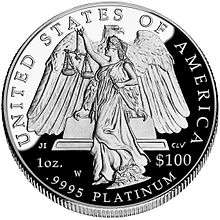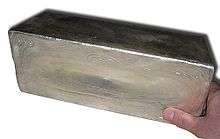Troy ounce


The troy ounce (oz t) is a unit of imperial measure, now commonly used to measure the mass (weight, in common parlance) of precious metals.[1] One troy ounce is defined as exactly 31.1034768 g (1.097142857143 oz.), which may be used to denote the value of a precious metal. One troy ounce of gold is denoted with the ISO 4217 currency code XAU, while one troy ounce of silver is denoted as XAG.[2]
The troy ounce is about 10% heavier (ratio 192/175) than the avoirdupois ounce, used for everyday purposes in the United States.
Etymology
The name "troy" is first attested in 1390. Though it is often connected to a fair at the city of Troyes, France,[3] this story may have been invented in the 18th century.[4]
History
The troy ounce is part of the troy weights system, many aspects of which were indirectly derived from the Roman monetary system. The Romans used bronze bars of varying weights as currency. An aes grave ("heavy bronze") weighed 1 pound. One twelfth of an aes grave was called an uncia, or in English an "ounce". Later the avoirdupois ounce was standardised as 1⁄16 of a pound, but the troy ounce, which is 1⁄12 of a troy pound (a troy pound is lighter than an avoirdupois pound), is still used for measuring precious metals. At 480 grains, the troy ounce is about 10% heavier than the avoirdupois ounce, which is defined to equal 437 1⁄2 grains and is 28.349523125 g (exact).[5]
The troy ounce and grain were also part of the apothecaries' system. This was long used in medicine, but has now been largely replaced by the metric system (milligrams).[6]
The troy ounce in use today is essentially the same as the British Imperial troy ounce (1824–1971), adopted as an official weight standard for United States coinage by Act of Congress on May 19, 1828.[7] The British Imperial troy ounce (known more commonly simply as the imperial troy ounce) was based on, and virtually identical with, the pre-1824 British troy ounce and the pre-1707 English troy ounce. (1824 was the year the British Imperial system of weights and measures was adopted, 1707 was the year of the Act of Union which created the Kingdom of Great Britain.) The English troy ounce was officially adopted for coinage in 1527. Troy ounces have been used in England since about 1400. Before that, various sorts of troy ounces were in use on the continent.[4]
Troy ounces are still often used in precious metal markets in countries that otherwise use International System of Units (SI),[8][9] except in East Asia.[10] The People's Bank of China, in particular, which has never historically used troy measurements, has begun issuing Gold Pandas minted according to SI weights.
See also
References
- ↑ "Status Report of U.S. Government Gold Reserve", Bureau of the Fiscal Service
- ↑ "Table A.1 (E): Currency and funds codes list" (MS Excel file). SIX Interbank Clearing Ltd, the ISO 4217 Maintenance Agency.
- ↑ Oxford English Dictionary, Second edition, 1989; online version September 2011
- 1 2 Zupko, Ronald Edward (1977). British Weights and Measures: A History from Antiquity to the Seventeenth Century. University of Wisconsin Press. pp. 28–9. ISBN 978-0-299-07340-4.
- ↑ "Statutory Instrument 1994 No. 2867: The Units of Measurement Regulations 1994". Retrieved 2010-01-10.
- ↑ "Troy Ounce". WordNet 3.0, Dictionary.com. Princeton University. Retrieved 2008-01-10.
- ↑ Hallock, Wade (1906). Outlines of the evolution of weights and measures and the metric system. The Macmillan company. p. 119.
- ↑ http://www.boerse-frankfurt.de/de/rohstoffe/xetra+gold
- ↑ "Units of Measure - The Perth Mint".
- ↑ "Do grams or ounces win?".